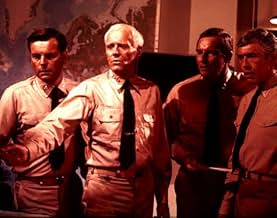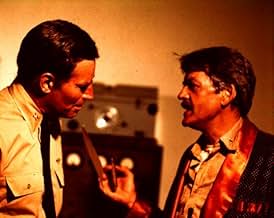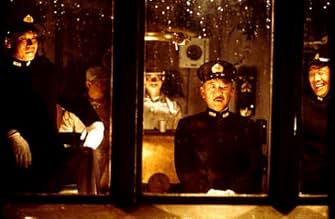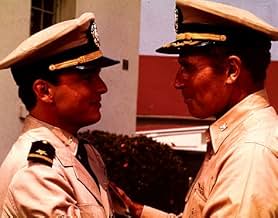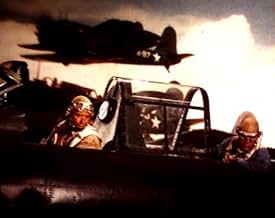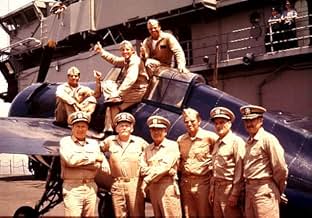Die Schlacht um Midway im Pazifik gilt gemeinhin Wendepunkt des Zweiten Weltkriegs.Die Schlacht um Midway im Pazifik gilt gemeinhin Wendepunkt des Zweiten Weltkriegs.Die Schlacht um Midway im Pazifik gilt gemeinhin Wendepunkt des Zweiten Weltkriegs.
Toshirô Mifune
- Admiral Isoroku Yamamoto
- (as Toshiro Mifune)
Handlung
WUSSTEST DU SCHON:
- WissenswertesKevin Dobson's character Ensign George Gay, was the sole survivor of Torpedo Squadron 8. Gay wrote a book about his experiences (Sole Survivor) and was an advisor on this film.
- PatzerWhen the cockpit of one of the planes catches fire, the pilot pulls out a fire extinguisher. It is a more modern one, not a fire extinguisher that would have existed in the 1940s.
- Zitate
Vice Adm. Chuichi Nagumo: [commenting on the American torpedo bombers] They sacrifice themselves like samurai, these Americans.
- Alternative VersionenA television version exists, with additional cast and plot. It runs four hours with commercials. The main plot points are a Charlton Heston-Susan Sullivan romance and the Coral Sea battle (reffered to in the other version) is played out like the Midway battle. The Coral Sea battle heavily features Mitchell Ryan as Admiral Aubrey Fitch and also includes a subplot where a young Japanese pilot who'd met with Admiral Nagumo to express his opposition to Japanese military action is shot down. At the end of the TV version, Sullivan and Christine Kukobo are both shown waiting dockside.
- VerbindungenEdited from Salute to the Marines (1943)
- SoundtracksIn the Mood
Music by Joe Garland
Performed by the Glenn Miller and His Orchestra (as Glenn Miller Orchestra) on the jukebox at the bar in Hawaii
Ausgewählte Rezension
Saturday night TV is a bit of a dead zone down here so I suppose one should be grateful for the odd watchable movie, even if its 20 years old. This one looks older than it actually is, due to the liberal use of stock footage and a cast that's a retirement counsellor's dream. A relatively youthful Charlton Heston is in the lead, but there's Henry Fonda, Glenn Ford, Robert Mitchum, Robert Webber and even the great Japanese actor Toshiro Mifune. A curious aspect is that every military character with a speaking part is an officer; the grunts just get to grunt. It's very much the view from the bridge (and the pilot's seat). Despite this aspect and the attempt at historical realism it's not made clear quite how it was that the Japanese made the error that cost them the battle, getting caught with their flightdecks full just as the American torpedo bombers arrived. The contribution of the American land-based aircraft is also given scant recognition.
Still you do get a bit of a story, though the less said about the silly sub-plot involving the Heston character's son and a Japanese-American girl the better. The director, Jack Smight had extensive T V experience, as did many of the younger actors, and this shows up in the rather static dialogue scenes you get when you aren't allowed to move the cameras much. The Japanese voices are dubbed, so that Paul Free, the voice of Boris Badenov in "Bullwinkle," (and countless other cartoon characters) is Admiral Yamamoto. The music was written by John Williams who a year or so later did the music for "Star Wars" and you can sense the similarities.
In the film the military operations side of things abounds with anacronisms, partly due to the liberal use of stock footage as mentioned. I don't think you can be too hard on the producers (the low profile but financially successful Mirisch Brothers) for not using a real Japanese World War 2 aircraft carrier since they are all at the bottom of the sea, but the crashed jet on the Yorktown's flightdeck was a bit sloppy. "Tora Tora Tora," which cost more money, was a better film. Not because it cost more money but because it was more carefully made, more balanced (both side's story told well) and more honest, perhaps also because it dealt with defeat rather than victory from the American viewpoint. "Midway" has some suspense, plenty of action, and the the patriotism drum is not banged to the point of pain.
Still you do get a bit of a story, though the less said about the silly sub-plot involving the Heston character's son and a Japanese-American girl the better. The director, Jack Smight had extensive T V experience, as did many of the younger actors, and this shows up in the rather static dialogue scenes you get when you aren't allowed to move the cameras much. The Japanese voices are dubbed, so that Paul Free, the voice of Boris Badenov in "Bullwinkle," (and countless other cartoon characters) is Admiral Yamamoto. The music was written by John Williams who a year or so later did the music for "Star Wars" and you can sense the similarities.
In the film the military operations side of things abounds with anacronisms, partly due to the liberal use of stock footage as mentioned. I don't think you can be too hard on the producers (the low profile but financially successful Mirisch Brothers) for not using a real Japanese World War 2 aircraft carrier since they are all at the bottom of the sea, but the crashed jet on the Yorktown's flightdeck was a bit sloppy. "Tora Tora Tora," which cost more money, was a better film. Not because it cost more money but because it was more carefully made, more balanced (both side's story told well) and more honest, perhaps also because it dealt with defeat rather than victory from the American viewpoint. "Midway" has some suspense, plenty of action, and the the patriotism drum is not banged to the point of pain.
Top-Auswahl
Melde dich zum Bewerten an und greife auf die Watchlist für personalisierte Empfehlungen zu.
- How long is Midway?Powered by Alexa
Details
Box Office
- Bruttoertrag in den USA und Kanada
- 43.220.000 $
- Eröffnungswochenende in den USA und in Kanada
- 4.356.666 $
- 20. Juni 1976
- Laufzeit2 Stunden 12 Minuten
- Farbe
- Seitenverhältnis
- 2.39 : 1
Zu dieser Seite beitragen
Bearbeitung vorschlagen oder fehlenden Inhalt hinzufügen

Oberste Lücke
By what name was Schlacht um Midway (1976) officially released in India in English?
Antwort

